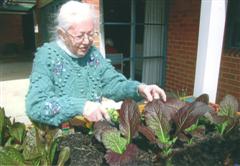Community story
By Sue Foley of Peninsula Health © Dementia Care International
Sue introduces horticultural therapy to the aged care sector and shares with our readers the many tips and benefits.
‘Horticultural Therapy is a process of using plants and garden related activities to promote well-being of people’s mind, body and spirit’ – HTAV.
Our residents range from high-care to low-care. All have varying degrees of health issues relating to aging, including dementia, loss of mobility and limited dexterity.
 Within our horticultural therapy program, we focus on abilities not limitations. All garden group sessions are planned according to the seasons, the abilities of the group members and the wishes of participants. Gentle gardening sessions are conducted using raised garden beds (for vegetables and flowers etc.) to reduce bending and lifting. Hand tools are light weight and some have long handles enabling the rear of the raised beds to be cultivated with greater ease. Activities such as potting, planting up window boxes, taking cuttings or sowing bulbs are all done at table height.
Within our horticultural therapy program, we focus on abilities not limitations. All garden group sessions are planned according to the seasons, the abilities of the group members and the wishes of participants. Gentle gardening sessions are conducted using raised garden beds (for vegetables and flowers etc.) to reduce bending and lifting. Hand tools are light weight and some have long handles enabling the rear of the raised beds to be cultivated with greater ease. Activities such as potting, planting up window boxes, taking cuttings or sowing bulbs are all done at table height.
Activities
Our garden craft sessions include activities such as pressing flowers, making pot-pourri, and flower arranging. Activities are broken down into simple steps and 1:1 assistance is given as required. Much pride is taken in our results; always keeping in mind that it is the journey that is important not the precision of the finished product.
In the warmer months, we go on bus outings to interesting local gardens and parks where residents can take pleasure in beautiful garden surroundings while enjoying a picnic or afternoon tea.
Activities may involve active participation or more passive enjoyment through stimulation of the senses. Sensory based activities are offered for high care residents – often in the late stages of dementia. These may involve the purely sensory experience of simply enjoying sitting or walking in the garden stimulated by the different sights, sounds, touch and fragrances. These can evoke pleasant memories of past experiences and provide stimuli for reminiscence. If the weather is inclement, indoor activities may include enjoying relaxing music while viewing, feeling, and tasting a variety of herbs picked fresh from the garden. In summer, lavender is picked, bunched and tied, or made into fragrant sachets for indoor appreciation.
Designing a Dementia Specific Garden
Gardens for people with dementia should be designed taking into consideration many factors including:
- level, even-surfaced paths for adequate wheelchair or 4WW access.
- paths in a loop design, so users can follow a pathway without arriving at a dead-end which may cause confusion.
- fencelines screened with plantings to create a comfortable, enclosed environment without obvious barriers.
- features, such as raised garden beds, suitable seating and shelter from the wind and sun.
- introduction of the element of sound, a water feature, bird-feeders and bird baths.
- plants for their cultural suitability, visual appeal (including seasonal variations), functional role (for e.g. screening, shade and suitability for use in garden craft sessions), and a range of fragrances and textural differences.
Benefits
The benefits of horticultural therapy are many and varied and positive outcomes can be summarised as:
- helps to maintain physical and mental health
- provides cognitive and sensory stimulation
- maintains social skills increases confidence and self-esteem
- maintains spiritual well-being.
We can all benefit through learning from life-time gardeners sharing their stories, skills, humour and wisdom.

.jpg)